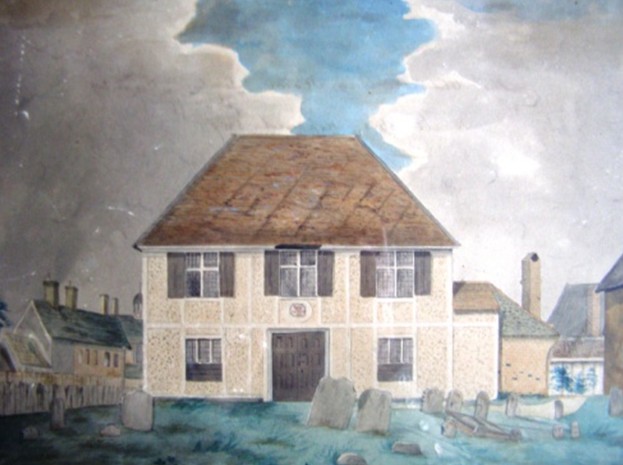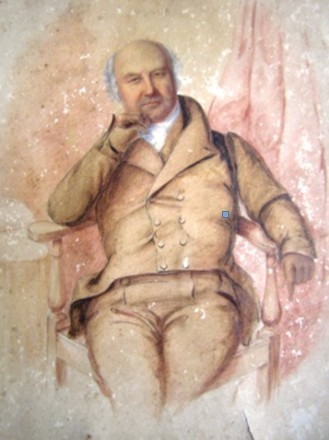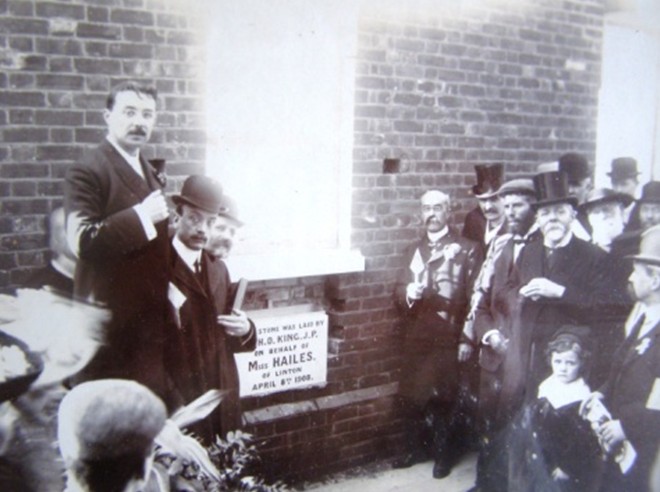Brief History of Linton Free Church
This history was compiled by a current member of the church.
The present building of
Linton Free Church dates back to 1818, but the site was home to dissenting families from the 1690’s onwards.
After the
Act of Toleration in 1689, the independents were able to register a barn as their place of worship and within a few years they had a large congregation.
A Chapel was then built off Horn Lane in 1698, west of the river.
 Original painting of 1698 Meeting House presented in 1914
Original painting of 1698 Meeting House presented in 1914
It was built in Thomas Huppup’s orchard which was at the bottom of his long High Street plot on which all the properties in Horn Lane south backed.
Inside, a large pulpit faced a singer’s gallery over the door, and two other galleries were built in 1703-04.
The congregation, including people from other parishes, numbered 83 adults in 1703 and had grown to 147 by 1728.
The building faced south (the opposite of today), over the meadows, and access was by way of a footbridge over the Grip stream.
About a century later, the plot in Horn Lane which was adjacent to the meeting house, was bequeathed to the church by Edmund Taylor, the tanner and miller, so that when the
present Meeting House was built in 1818 (at a cost of £1000) it faced Horn Lane, and the plot became the forecourt, as it is today.
The congregation declined to 100 (with only 17 full members) by the 1790’s when there was a sharp division over a new minister. In 1797, the larger faction called a minister named Thomas Hopkins, whose energy revived the chapel.
In 1799, he started a Sunday School, which was a great success, with 150 pupils in 1833. The church grew under his leadership.
In 1817, the old meeting house was pulled down and the current building was finished in 1818. The organ was installed in 1827. By 1851, the attendance averaged 280-350, besides 50 Sunday school pupils. By 1850, the chapel owned a Manse by the Red Lion (which was once on the corner of the High Street and Horn Lane).
 Thomas Hopkins
The hall
Thomas Hopkins
The hall on the side of the chapel was built in 1908 to house the Sunday school and was linked to the chapel building at a later date. Miss. Hailes of Linton made the whole project possible by donating £300 to the building fund.
 The Opening of the Church Hall, 1908
The Opening of the Church Hall, 1908
In 1972, the chapel was affiliated to the United Reformed Church.
Things to look for in the church and grounds:
-
Family names on graves: Whiffin, Smoothy, Kidman, Simkins, Pammenter
-
Family burial chambers - the subject of a preservation order
This page can be downloaded as a printable PDF in booklet format by clicking
here.
For further information about the history of Linton, see http://www.lintonhistory.org.uk or purchase a Linton Heritage Trail booklet from the Post Office.
Head back to our homepage to find out more about Linton Free Church and all we get up to now.